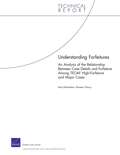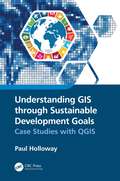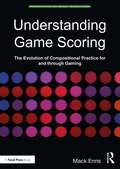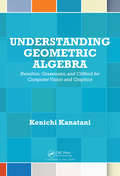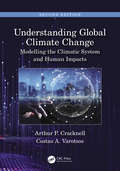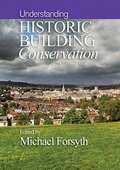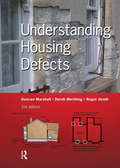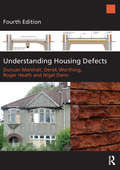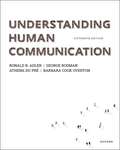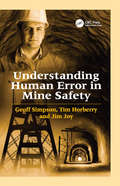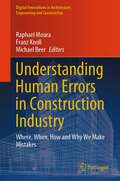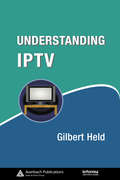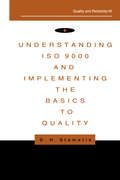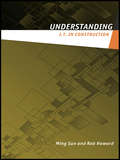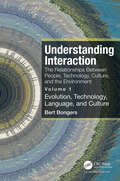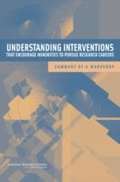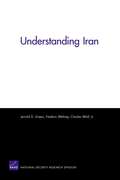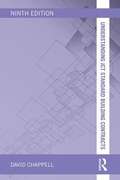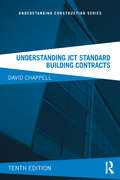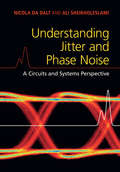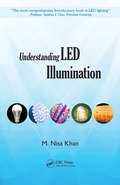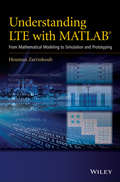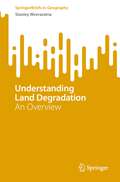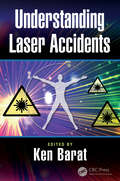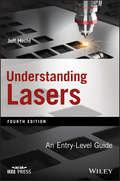- Table View
- List View
Understanding Forfeitures
by Noreen Clancy Amy RichardsonThe Treasury Executive Office for Asset Forfeiture (TEOAF) administers the Treasury Forfeiture Fund (TFF), which receives deposits of nontax forfeitures made by current and former Treasury agencies. Participating agencies use TFF funds to disrupt and dismantle criminal enterprises. This report examines the relationship between targeted funding support of major financial investigations and the forfeiture outcomes of such investigations.
Understanding GIS through Sustainable Development Goals: Case Studies with QGIS
by Paul HollowayUnderstanding GIS through Sustainable Development Goals applies a pedagogical shift to learning GIS, as the readers employ the concepts and methodologies on real-world problems. This book provides 16 case studies across most of the Sustainable Development Goals (SDGs) with step-by-step practical instructions using QGIS(Quantum Geographic Information System) , an open-source software. It helps readers develop GIS skills on real-world data, while learning the fundamentals including spatial data models, projections, and spatial databases, different cartographic methods, such as graduated symbology, change maps, and dynamic visualization, as well as more intermediate and advanced spatial analysis such as geoprocessing, multiple criteria analysis, and spatial statistics. The topics chosen are taught in secondary and tertiary education institutions which make this a textbook for all students and educators. Features: Focuses on learning GIS through 16 real world case studies. Introduces an open-source software that can be used beyond the classroom. Analyzes Sustainable Development Goals in a global framework and provides an alternative approach to learning GIS. Supports both secondary and tertiary educators and improves GIS education at all levels. Contains a holistic range of case studies that extend across several disciplines, from geography education, environmental sciences, geosciences, natural sciences, social sciences, and digital humanities. This is a textbook for all students and educators, providing 16 case studies across most of the SDGs with step-by-step practical instructions using QGIS, an open-source software.
Understanding Game Scoring: The Evolution of Compositional Practice for and through Gaming (Perspectives on Music Production)
by Mack EnnsUnderstanding Game Scoring explores the unique collaboration between gameplay and composition that defines musical scoring for video games. Using an array of case studies reaching back into the canon of classic video games, this book illuminates the musical flexibility, user interactivity and sound programming that make game scoring so different from traditional modes of composition. Mack Enns explores the collaboration between game scorers and players to produce the final score for a game, through case studies of the Nintendo Entertainment System sound hardware configuration, and game scores, including the canonic scores for Super Mario Bros. (1985) and The Legend of Zelda (1986). This book is recommended reading for students and researchers interested in the composition and production of video game scores, as well as those interested in ludo-musicology.
Understanding Geometric Algebra: Hamilton, Grassmann, and Clifford for Computer Vision and Graphics
by Kenichi KanataniUnderstanding Geometric Algebra: Hamilton, Grassmann, and Clifford for Computer Vision and Graphics introduces geometric algebra with an emphasis on the background mathematics of Hamilton, Grassmann, and Clifford. It shows how to describe and compute geometry for 3D modeling applications in computer graphics and computer vision.Unlike similar texts
Understanding Global Climate Change: Modelling the Climatic System and Human Impacts
by Arthur P Cracknell Costas A VarotsosClimate change, a familiar term today, is far more than just global warming due to atmospheric greenhouse gases including CO2. In order to understand the nature of climate change, it is necessary to consider the whole climatic system, its complexity, and the ways in which natural and anthropogenic activities act and influence that system and the environment. Over the past 20 years since the first edition of Understanding Global Climate Change was published, not only has the availability of climate-related data and computer modelling changed, but our perceptions of it and its impact have changed as well. Using a combination of ground data, satellite data, and human impacts, this second edition discusses the state of climate research today, on a global scale, and establishes a background for future discussions on climate change. This book is an essential reference text, relevant to any and all who study climate and climate change. Features Provides a thought-provoking and original approach to the science of climate. Emphasises that there are many factors contributing to the causation of climate change. Clarifies that while anthropogenic generation of carbon dioxide is important, it is only one of several human activities contributing to climate change. Considers climate change responses needed to be undertaken by politicians and society at national and global levels. Totally revised and updated with state-of-the-art satellite data and climate models currently in operation around the globe.
Understanding Historic Building Conservation (Historic Building Conservation)
by Michael ForsythThis book is the first in a series of volumes that combine conservation philosophy in the built environment with knowledge of traditional materials, and structural and constructional conservation techniques and technology: • Understanding Historic Building Conservation • Materials & Skills in Historic Building Conservation • Structures & Construction in Historic Building Conservation The series aims to introduce each aspect of conservation and to provide concise, basic and up-to-date knowledge for architects, surveyors and engineers as well as for commissioning client bodies, managers and advisors. In each book, Michael Forsyth draws together chapters by leading architects, structural engineers and related professionals to reflect the interdisciplinary nature of conservation work. The books are structured to be of direct practical application, taking the reader through the process of historic building conservation and emphasising throughout the integrative teamwork involved. This present volume – Understanding Historic Building Conservation – discusses conservation philosophy and the importance of understanding the history of a building before making strategic decisions. It details the role of each conservation team member and sets out the challenges of conservation at planning level in urban, industrial and rural contexts and in the conservation of designed landscapes. The framework of legislation and charters within which these operate is described and the book also provides guidance on writing conservation plans, explains the fundamental issues of costing and contracts for conservation and highlights the importance of maintenance. Eighteen chapters written by the experts present today’s key issues in historic building conservation: Timothy Cantell, Martin Cherry, Nigel Dann, Peter Davenport, Geoff Evans, Keith Falconer, Colin Johns, Jeremy Lake, Jonathan Lovie, Duncan McCallum, James Maitland Gard’ner, Martin Robertson, Adrian Stenning, David H. Tomback, Giles Waterfield, Philip Whitbourn, John Winter.
Understanding Housing Defects
by Derek Worthing Duncan Marshall Roger HeathThis third edition of Understanding Housing Defects provides a coherent and comprehensive introduction to the causes, investigation and diagnosis of defects in housing.Each of the eighteen chapters covers a specific building element and includes a brief introduction setting out construction principles and the evolution of current practice. Each chapter then goes on to look at the identification, cause and diagnosis of common (and sometimes not so common) defects. The text has been revised and extended with new sections on boundary walls, chimneys and basements. The Services chapter has been replaced with three new, more substantial chapters on heating and plumbing, electrical installations and drainage.
Understanding Housing Defects
by Derek Worthing Duncan Marshall Roger Heath Nigel DannUnderstanding Housing Defects provides a concise, coherent and comprehensive introduction to the causes, investigation and diagnosis of defects in domestic buildings. For this new edition, many of the chapters have been substantially updated and new photographs have been added. There are four new chapters covering: How defects are defined An overview of building and architectural history External joinery and painted finishes Environmental and health- related building problems Many of the 21 chapters cover a specific building element and include a brief introduction setting out construction principles and the evolution of current practice. All of the chapters consider the identification, cause and diagnosis of common (and sometimes not so common) defects. This book is a must have for all those students and practitioners who require a broad understanding of housing defects. Building surveyors, general practice surveyors, architects, estate agents, housing officers and anyone involved in the management and maintenance of property as well as its construction will benefit hugely from this highly informative full-colour text. Written by the authors of The Construction of Houses, the book is also the natural companion to this bestselling textbook.
Understanding Human Communication
by Ronald B. Adler George Rodman Copy Barbara Cook Overton Athena du PrÃUnderstanding Human Communication addresses students' perception that they already know how to communicate--an issue faced by every faculty member. By artfully weaving cutting-edge academic research and theory into the clear, down-to-earth, and student-friendly narrative, the authors help students understand the complexity and depth of human communication and public speaking. The series of concepts builds logically through the chapter sequence, enabling students to further deepen their communication skills as they progress through the book. By accessing the text's integrated digital resources--contemporary and brief video clips; tutorials; and self-assessments---students will be able to see concepts applied in real scenarios, making their learning more meaningful.
Understanding Human Error in Mine Safety
by Tim Horberry Geoff SimpsonThe consideration of human factors issues is vital to the mining industry. As in other safety-critical domains, human performance problems constitute a significant threat to system safety, making the study of human factors an important field for improving safety in mining operations. The primary purpose of this book is to provide the reader with a much-needed overview of human factors within the mining industry, in particular to understand the role of human error in mine safety, explaining contemporary risk management and safety systems approaches. The approach taken is multidisciplinary and holistic, based on a model of the systems of work in the mining industry domain. The ingredients in this model include individual operators, groups/teams, technology/equipment, work organisation and the physical environment. Throughout the book, topics such as human error and safety management are covered through the use of real examples and case studies, allowing the reader to see the practical significance of the material presented while making the text rigorous, useful and enjoyable. Understanding Human Error in Mine Safety is written for professionals in the field, researchers and students of mining engineering, safety or human factors.
Understanding Human Errors in Construction Industry: Where, When, How and Why We Make Mistakes (Digital Innovations in Architecture, Engineering and Construction)
by Michael Beer Raphael Moura Franz KnollThis book provides an analysis of the origin and effect of human errors in engineering. Using cases from everyday construction and large-scale accidents, the circumstances associated with the creation of errors are illustrated, along with strategies for their prevention, with the goal to eventually minimize cost overruns, delays, and accidents. The book features a discussion of the circumstances related to error proneness, the review of some sixty mishaps or near misses from real-life construction, the systematic analysis of 238 large-scale accidents in engineering systems, the perspective of psychology on the origin of faulty human performance, and a review of the relation of management to error proneness.
Understanding IPTV (Informa Telecoms & Media)
by Gilbert HeldDriven by a combination of technological improvements and commercial pressure, interest in IPTV services has increasingly grown. IPTV refers to the use of the Internet protocol required for delivery of television content. IPTV represents an emerging technology that could change the manner in which homes receive entertainment, personal computers ope
Understanding ISO 9000 and Implementing the Basics to Quality (Quality And Reliability Ser. #45)
by D.H. StamatisThis work examines the evolution and rationale of the ISO 9000 series of standards, their structure, interpretation and relationship to other quality systems. Theory and applications are provided, and the author explains how to put the standards into place and achieve quality. Specific methods and tools for the implementation of the ISO standards that lead to certification and certification maintenance are supplied.
Understanding IT in Construction
by Ming Sun Rob HowardIn recent years, Information Technology (IT) has been transforming business practice in many sectors resulting in efficiency gains and improved services for the client. The construction industry lags behind other manufacturing and service industries in adopting the new technology. To promote the wider use of IT in construction, it is essential to equip practitioners and graduates of construction related disciplines with knowledge of existing construction IT applications. This book provides an overview of a broad range of IT applications currently available for all stages throughout the life cycle of a building project, from essential office and information management through to computer-aided design (CAD), cost estimating, project planning and scheduling, and facilities management and building maintenance. It is an invaluable and handy reference for construction professionals and clients, as well as being a clear and comprehensive text for students studying construction, building or architectural courses.
Understanding Interaction: Volume 1: Evolution, Technology, Language and Culture
by Bert BongersUnderstanding Interaction explores the interaction between people and technology in the broader context of the relations between the human-made and the natural environments. It is not just about digital technologies – our computers, smartphones, the Internet – but all our technologies, such as mechanical, electrical, and electronic. Our ancestors started creating mechanical tools and shaping their environments millions of years ago, developing cultures and languages, which in turn influenced our evolution. Volume 1 looks into this deep history, starting from the tool-creating period (the longest and most influential on our physical and mental capacities) to the settlement period (agriculture, domestication, villages and cities, written language), the industrial period (science, engineering, reformation, and renaissance), and finally the communication period (mass media, digital technologies, and global networks). Volume 2 looks into humans in interaction – our physiology, anatomy, neurology, psychology, how we experience and influence the world, and how we (think we) think. From this transdisciplinary understanding, design approaches and frameworks are presented to potentially guide future developments and innovations. The aim of the book is to be a guide and inspiration for designers, artists, engineers, psychologists, media producers, social scientists, etc., and, as such, be useful for both novices and more experienced practitioners. Image Credit: Still of interactive video pattern created with a range of motion sensors in the Facets kaleidoscopic algorithm (based underwater footage of seaweed movement) by the author on 4 February 2010, for a lecture at Hyperbody at the Faculty of Architecture, TU Delft, NL.
Understanding Interventions That Encourage Minorities To Pursue Research Careers: Summary Of A Workshop
by National Research Council of the National AcademiesMinority groups are severely underrepresented in the scientific workforce. To encourage minorities to pursue careers in research, a variety of "intervention programs" have been created at the pre-college, college, and graduate school levels. While there is a belief that these programs often achieve their goals, there is relatively little understanding of the factors that contribute to that success. The Division of Minority Opportunities in Research (MORE) at the National Institute of General Medical Sciences of the National Institutes of Health has established a grant program to support research to better understand the factors that contribute to the success of intervention programs. The MORE Division asked the National Academies to organize a workshop focusing on issues addressed by the grant program. This workshop summary presents examples of previous research on intervention programs, describes ways to formulate effective research questions and conduct research to identify the key elements that lead to successful intervention programs, and outlines ways to foster a community of researchers in this area.
Understanding Iran
by Frederic Wehrey Jerrold D. Green Charles Jr. WolfA compact, user-friendly handbook for U.S. policymakers interested in understanding the Islamic Republic of Iran. It synthesizes existing analyses on Iran and draws from non-American experts with a different interpretive lens for viewing the seemingly opaque Iranian system. It provides short analytic observations about the processes, institutions, networks, and actors that define Iran's politics, strategy, economic policy, and diplomacy.
Understanding JCT Standard Building Contracts
by David ChappellThis ninth edition of David Chappell's bestselling guide has been revised to take into account changes made in 2011 to payment provisions, and elsewhere. This remains the most concise guide available to the most commonly used JCT building contracts: Standard Building Contract with quantities, 2011 (SBC11), Intermediate Building Contract 2011 (IC11), Intermediate Building Contract with contractor's design 2011 (ICD11), Minor Works Building Contract 2011 (MW11), Minor Works Building Contract with contractor's design 2011 (MWD11) and Design and Build Contract 2011 (DB11). Chappell avoids legal jargon but writes with authority and precision. Architects, quantity surveyors, contractors and students of these professions will find this a practical and affordable reference tool arranged by topic.
Understanding JCT Standard Building Contracts (Understanding Construction)
by David ChappellThis tenth edition of David Chappell’s bestselling guide has been revised to take into account changes made in 2016 to payment provisions, loss and/or expense, insurance and many other smaller but significant changes, and includes a section on performance bonds and guarantees. This remains the most concise guide available to the most commonly used JCT building contracts: Standard Building Contract with quantities, 2016 (SBC16), Intermediate Building Contract 2016 (IC16), Intermediate Building Contract with contractor’s design 2016 (ICD16), Minor Works Building Contract 2016 (MW16), Minor Works Building Contract with contractor’s design 2016 (MWD16) and Design and Build Contract 2016 (DB16). Chappell avoids legal jargon and writes with authority and precision. Architects, quantity surveyors, contractors and students of these professions will find this a practical and affordable reference tool arranged by topic.
Understanding Jitter and Phase Noise: A Circuits and Systems Perspective
by Nicola Da Dalt Ali SheikholeslamiGain an intuitive understanding of jitter and phase noise with this authoritative guide. Leading researchers provide expert insights on a wide range of topics, from general theory and the effects of jitter on circuits and systems, to key statistical properties and numerical techniques. Using the tools provided in this book, you will learn how and when jitter and phase noise occur, their relationship with one another, how they can degrade circuit performance, and how to mitigate their effects - all in the context of the most recent research in the field. Examine the impact of jitter in key application areas, including digital circuits and systems, data converters, wirelines, and wireless systems, and learn how to simulate it using the accompanying Matlab code. Supported by additional examples and exercises online, this is a one-stop guide for graduate students and practicing engineers interested in improving the performance of modern electronic circuits and systems.
Understanding LED Illumination
by M. Nisa KhanUnderstanding LED Illumination elucidates the science of lighting for light emitting diodes. It presents concepts, theory, simulations, and new design techniques that shine the spotlight on illumination, energy efficiency, and reducing electrical power consumption. The text provides an introduction to the fundamentals of LED lamp design, and highli
Understanding LTE with MATLAB
by Houman ZarrinkoubAn introduction to technical details related to the Physical Layer of the LTE standard with MATLAB®The LTE (Long Term Evolution) and LTE-Advanced are among the latest mobile communications standards, designed to realize the dream of a truly global, fast, all-IP-based, secure broadband mobile access technology.This book examines the Physical Layer (PHY) of the LTE standards by incorporating three conceptual elements: an overview of the theory behind key enabling technologies; a concise discussion regarding standard specifications; and the MATLAB® algorithms needed to simulate the standard.The use of MATLAB®, a widely used technical computing language, is one of the distinguishing features of this book. Through a series of MATLAB® programs, the author explores each of the enabling technologies, pedagogically synthesizes an LTE PHY system model, and evaluates system performance at each stage. Following this step-by-step process, readers will achieve deeper understanding of LTE concepts and specifications through simulations.Key Features:* Accessible, intuitive, and progressive; one of the few books to focus primarily on the modeling, simulation, and implementation of the LTE PHY standard* Includes case studies and testbenches in MATLAB®, which build knowledge gradually and incrementally until a functional specification for the LTE PHY is attained* Accompanying Web site includes all MATLAB® programs, together with PowerPoint slides and other illustrative examplesDr Houman Zarrinkoub has served as a development manager and now as a senior product manager with MathWorks, based in Massachusetts, USA. Within his 12 years at MathWorks, he has been responsible for multiple signal processing and communications software tools. Prior to MathWorks, he was a research scientist in the Wireless Group at Nortel Networks, where he contributed to multiple standardization projects for 3G mobile technologies. He has been awarded multiple patents on topics related to computer simulations. He holds a BSc degree in Electrical Engineering from McGill University and MSc and PhD degrees in Telecommunications from the Institut Nationale de la Recherche Scientifique, in Canada.www.wiley.com/go/zarrinkoub
Understanding Land Degradation: An Overview (SpringerBriefs in Geography)
by Stanley WeeraratnaMuch of the earth's population is dependent on agriculture as it provides food for their sustenance. Successful crop production depends to a considerable extent on land and climate. Soil is the main component of land and a fertile soil is essential for crop growth. However, soil fertility declines over the years mainly due to land degradation. Hence, implementing appropriate measures to control land degradation is important. It is the responsibility of the farmers and the governments to take action to control land degradation. Agricultural extension officers are involved in making farmers aware of land degradation and control measures. Planners and policy makers need scientific assessments on land degradation and its implications so that they could advice the relevant authorities who prepare the national programs and budgets. This book highlights issues related to land degradation, the causal factors and methods of control. The audience is agricultural practitioners and planners as well as students of agriculture. Environmentalists would also benefit by understanding the main issues related to land degradation discussed.
Understanding Laser Accidents
by Ken BaratUnderstanding Laser Accidents provides a comprehensive reference addressing a wide a spectrum of laser accidents. The under-reporting and misreporting of laser accidents creates a blind spot for the laser management of institutions, laser users and laser safety officers. This book attempts to lift that veil. By giving details of why laser accidents occur, accident preparation, where to find laser accident information, elements of laser accident investigation, role of lessons learned and regulatory oversight of laser use. Chapters include a look at pilot illumination, fiber telecommunication, light show incidents and more as well as a detailed and honest review of three laser events that hold a mirror up to researchers and industrial laser users. • Provides a comprehensive, single source devoted to laser accidents • Covers elements of laser accident preparedness • Provides detailed analysis of some laser accidents that share common threads across the research and industrial environment • Contains information on where to find laser accident information • Extensive information on the illumination of pilots • Reviews laser regulatory oversight, non-beam hazards and laser safety tools
Understanding Lasers: An Entry-Level Guide (Ieee Press Understanding Science And Technology Ser. #Vol. 1)
by Jeff HechtThe expanded fourth edition of the book that offers an essential introduction to laser technology and the newest developments in the field The revised and updated fourth edition of Understanding Lasers offers an essential guide and introduction that explores how lasers work, what they do, and how they are applied in the real world. The author—a Fellow of The Optical Society—reviews the key concepts of physics and optics that are essential for understanding lasers and explains how lasers operate. The book also contains information on the optical accessories used with lasers. Written in non-technical terms, the book gives an overview of the wide-variety laser types and configurations. Understanding Lasers covers fiber, solid-state, excimer, helium-neon, carbon dioxide, free-electron lasers, and more. In addition, the book also explains concepts such as the difference between laser oscillation and amplification, the importance of laser gain, and tunable lasers. The updated fourth edition highlights the most recent research and development in the field. This important resource: Includes a new chapter on fiber lasers and amplifiers Reviews new topics on physics of optical fibers and fiber lasers, disk lasers, and Ytterbium lasers Contains new sections on Laser Geometry and Implications, Diode Laser Structures, Optimal Parametric Sources, and 3D Printing and Additive Manufacturing Puts the focus on research and emerging developments in areas such as spectroscopy, slow light, laser cooling, and extremely precise measurements Contains appendices, glossary, and index that help make this book a useful reference Written for engineering and physics students, engineers, scientists, and technicians, the fourth edition of Understanding Lasers contains the basic concepts of lasers and the most recent advances in the technology.
